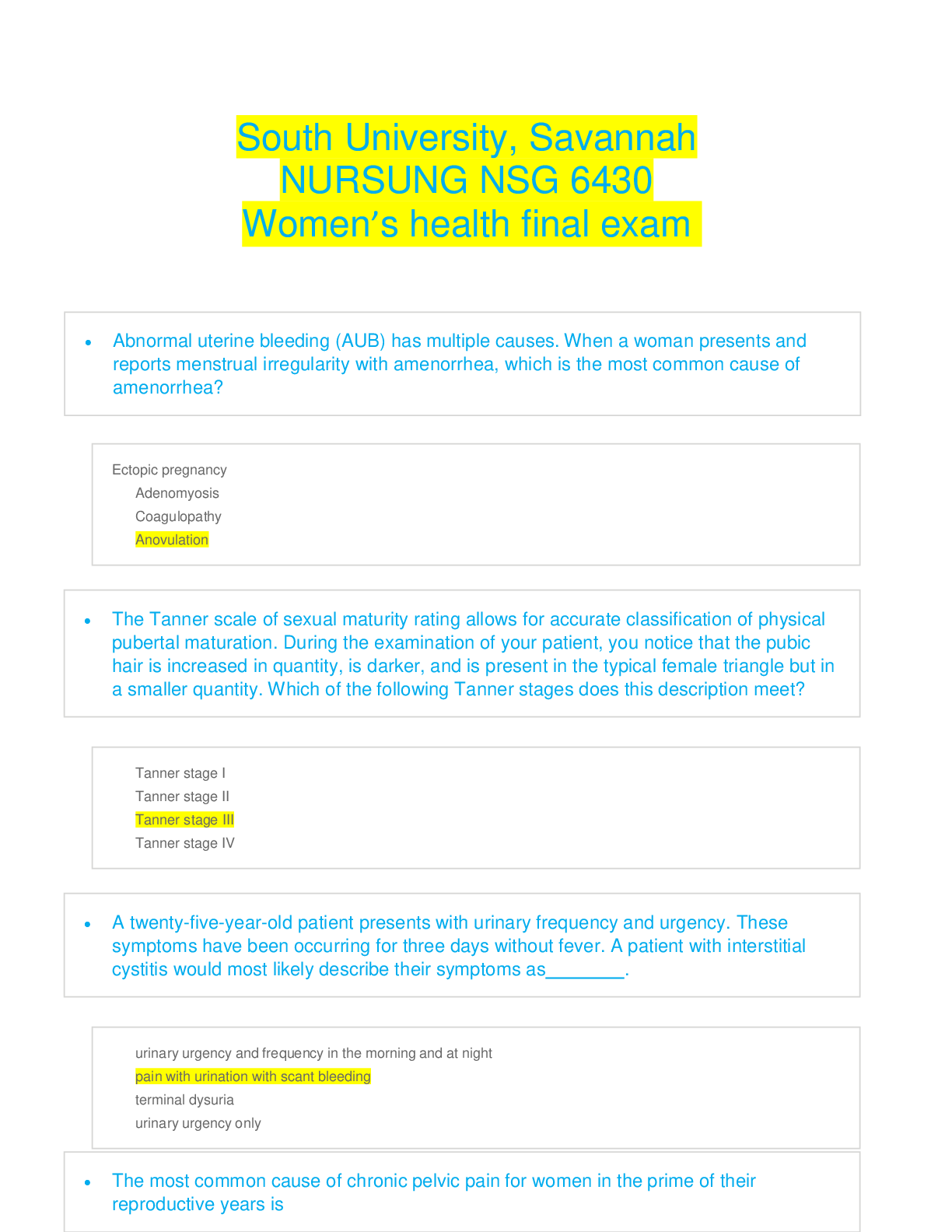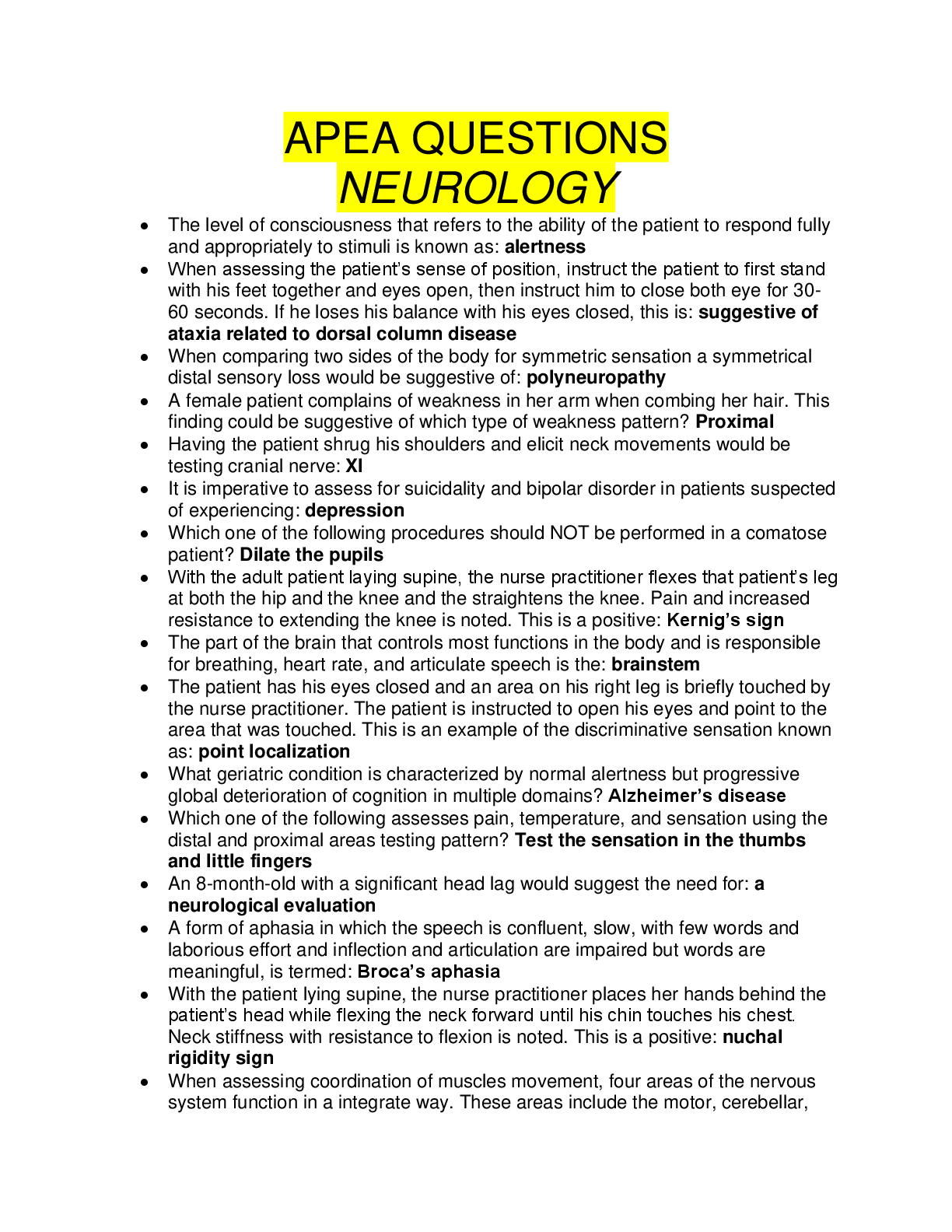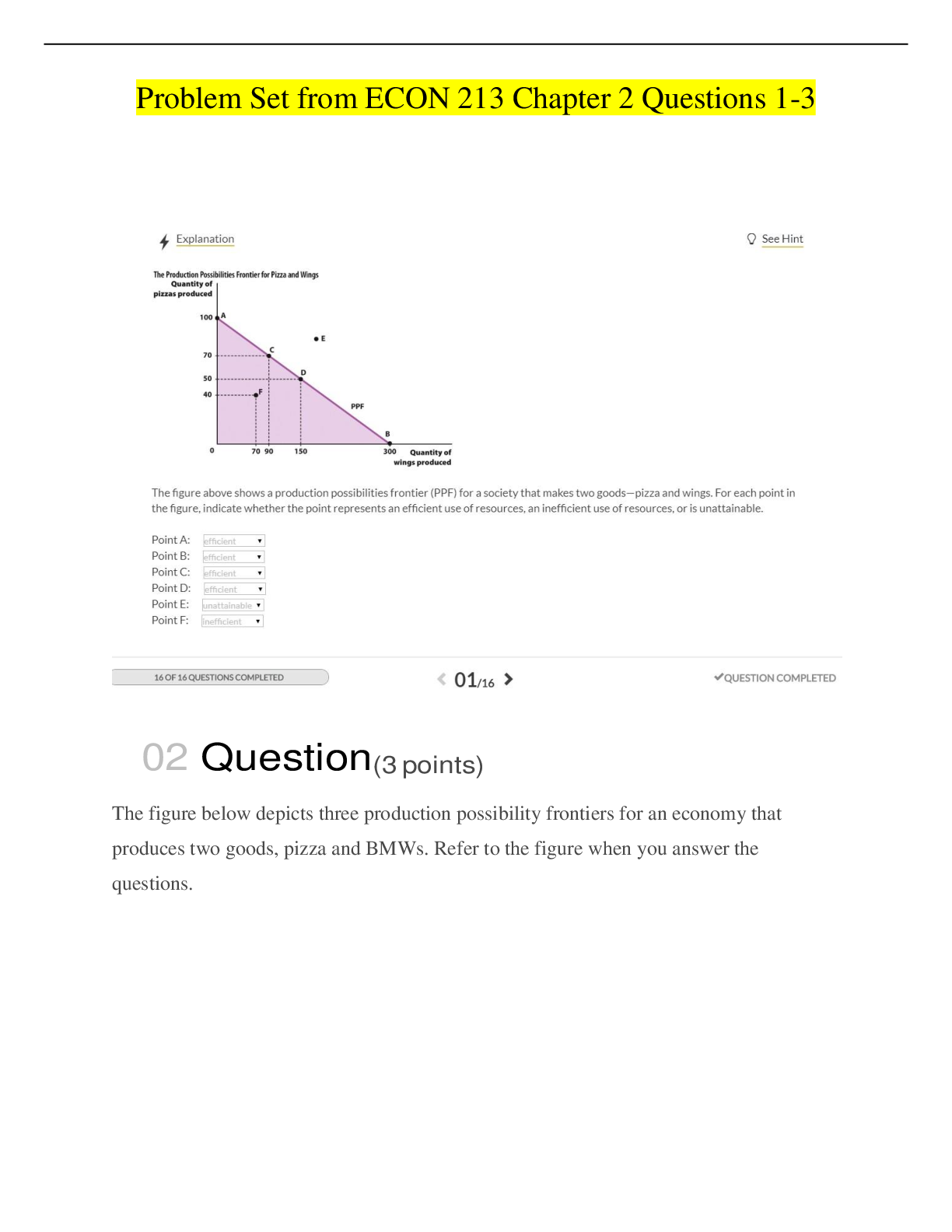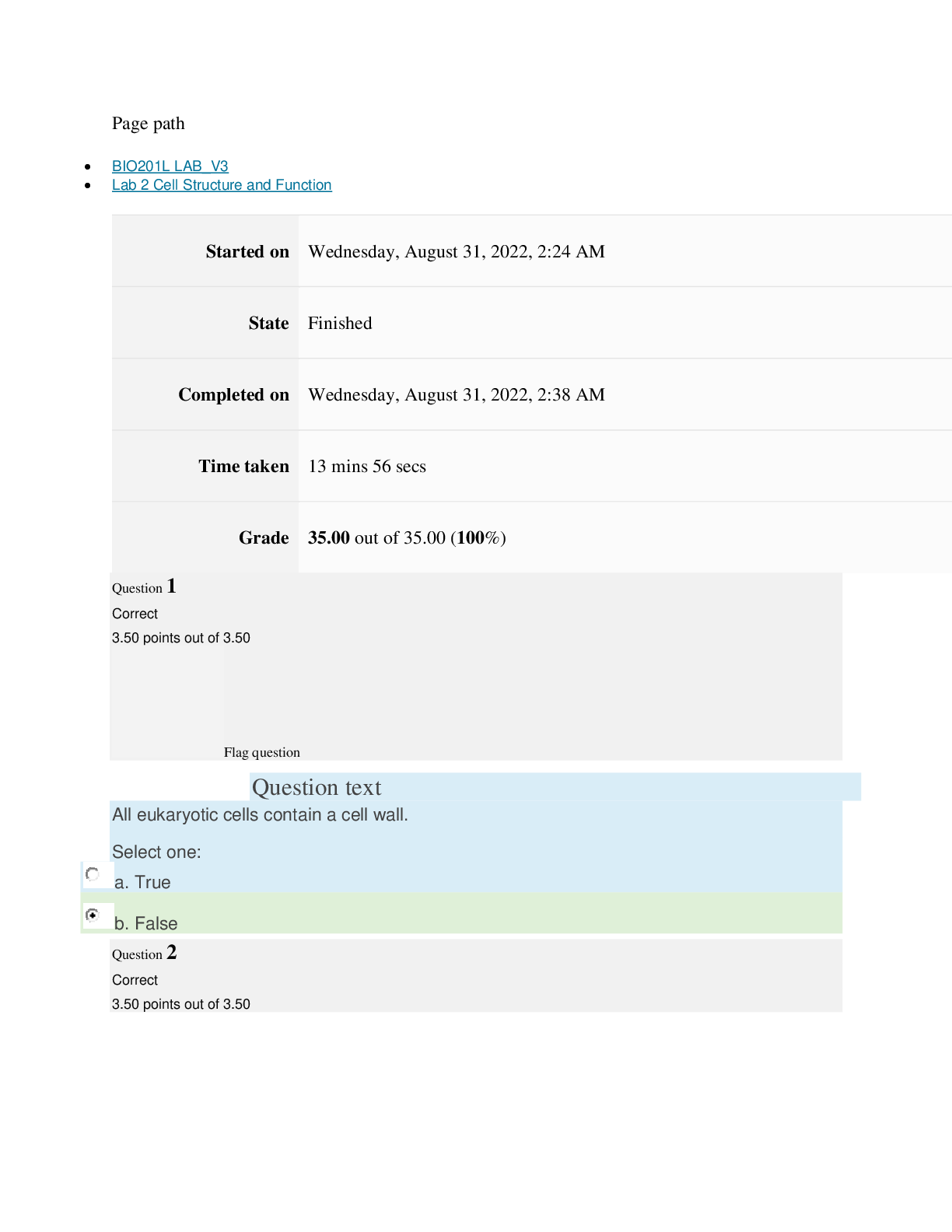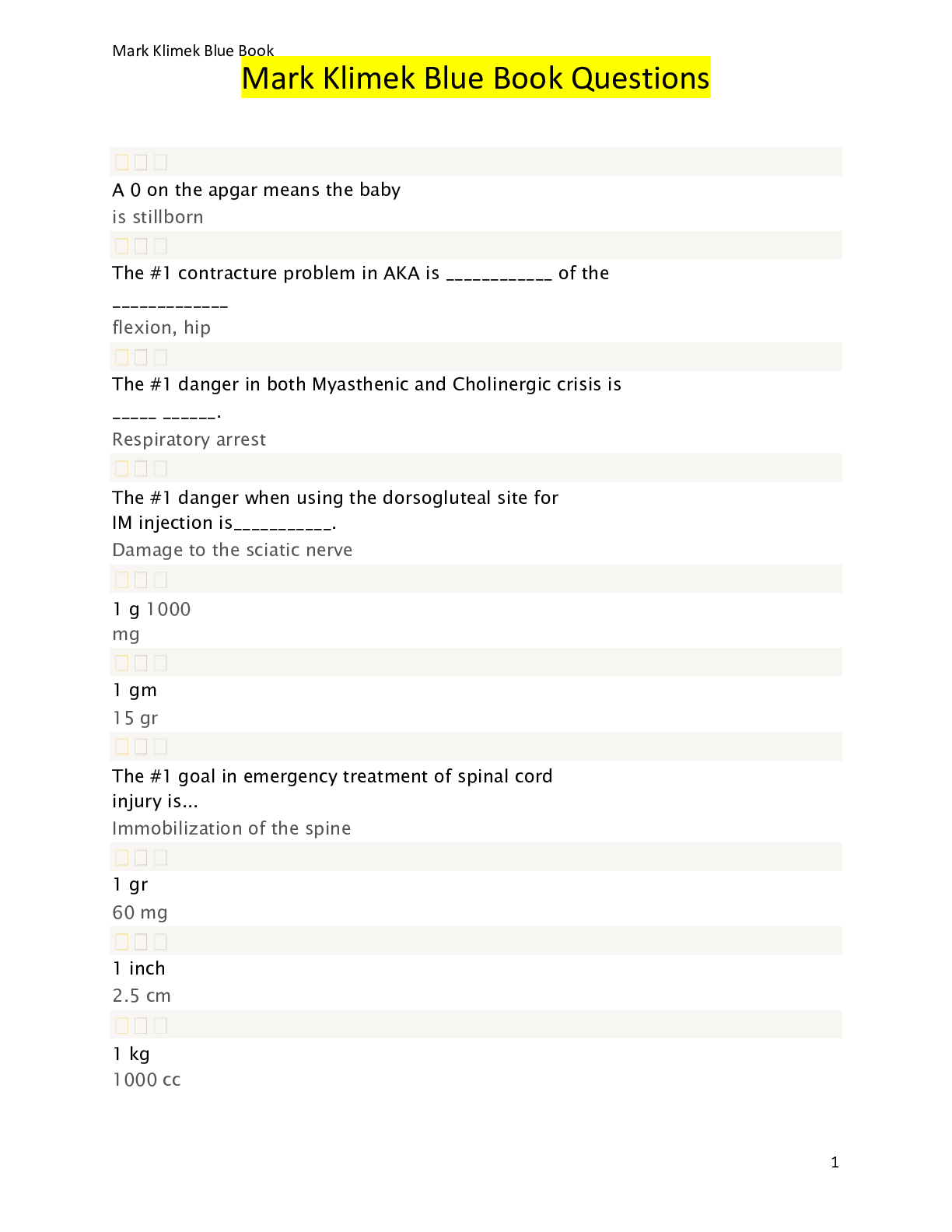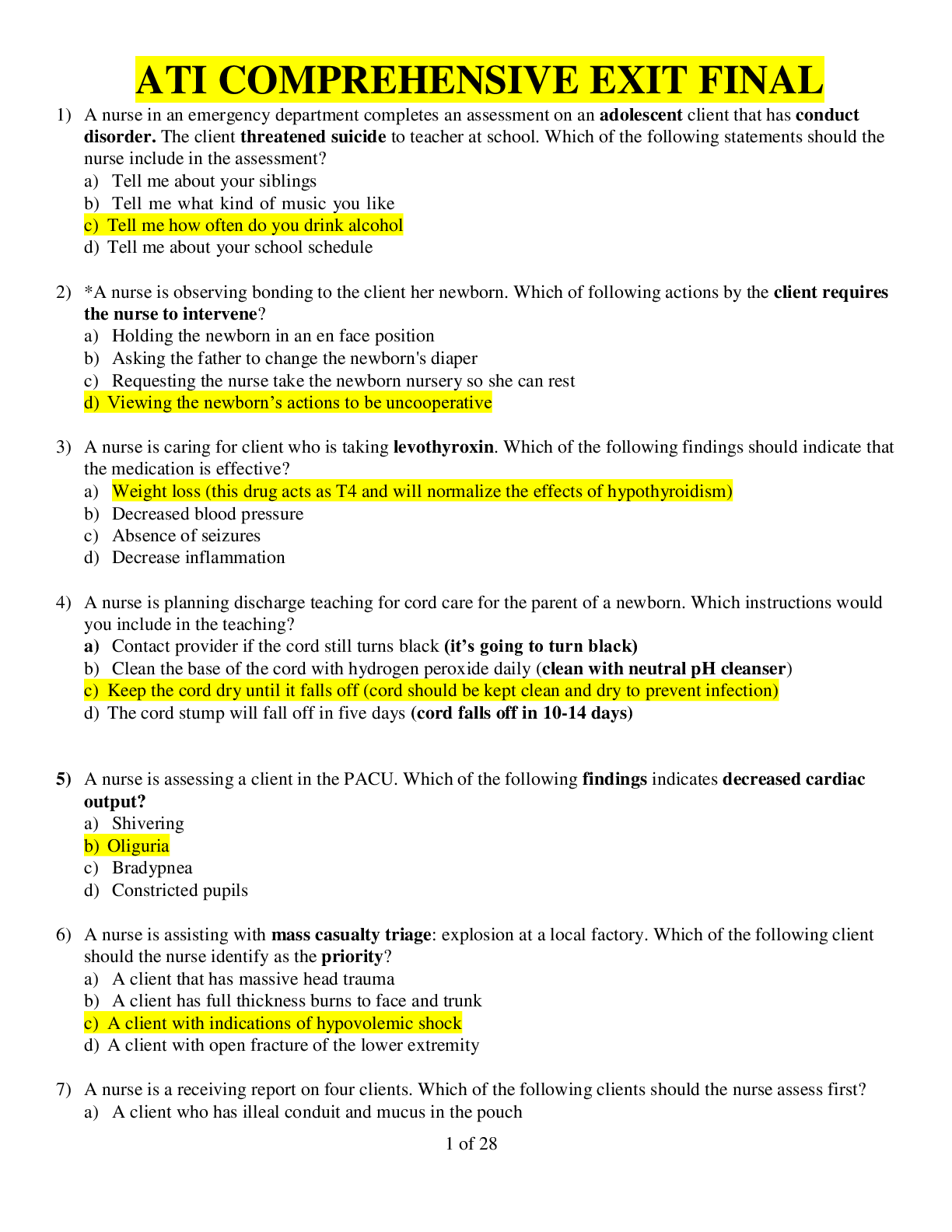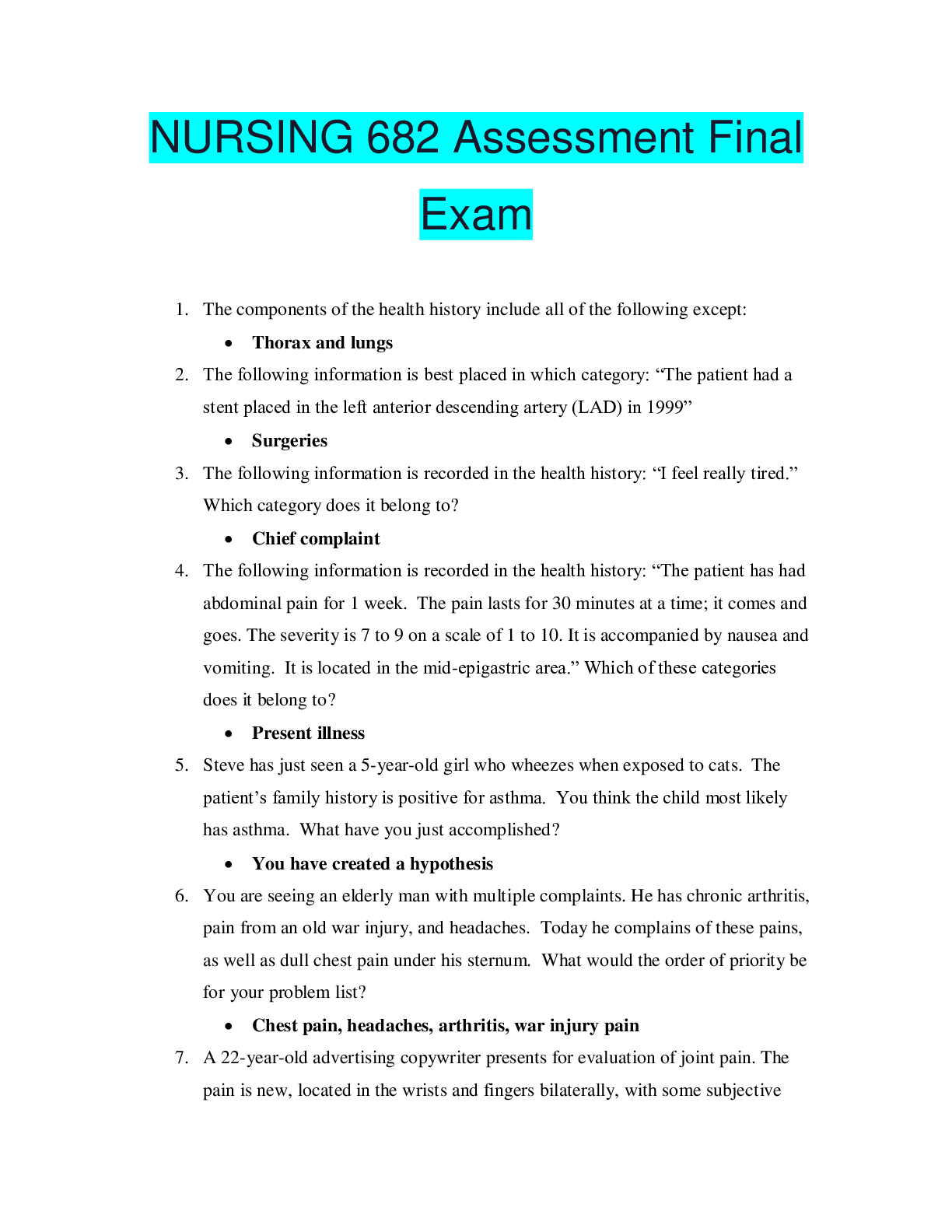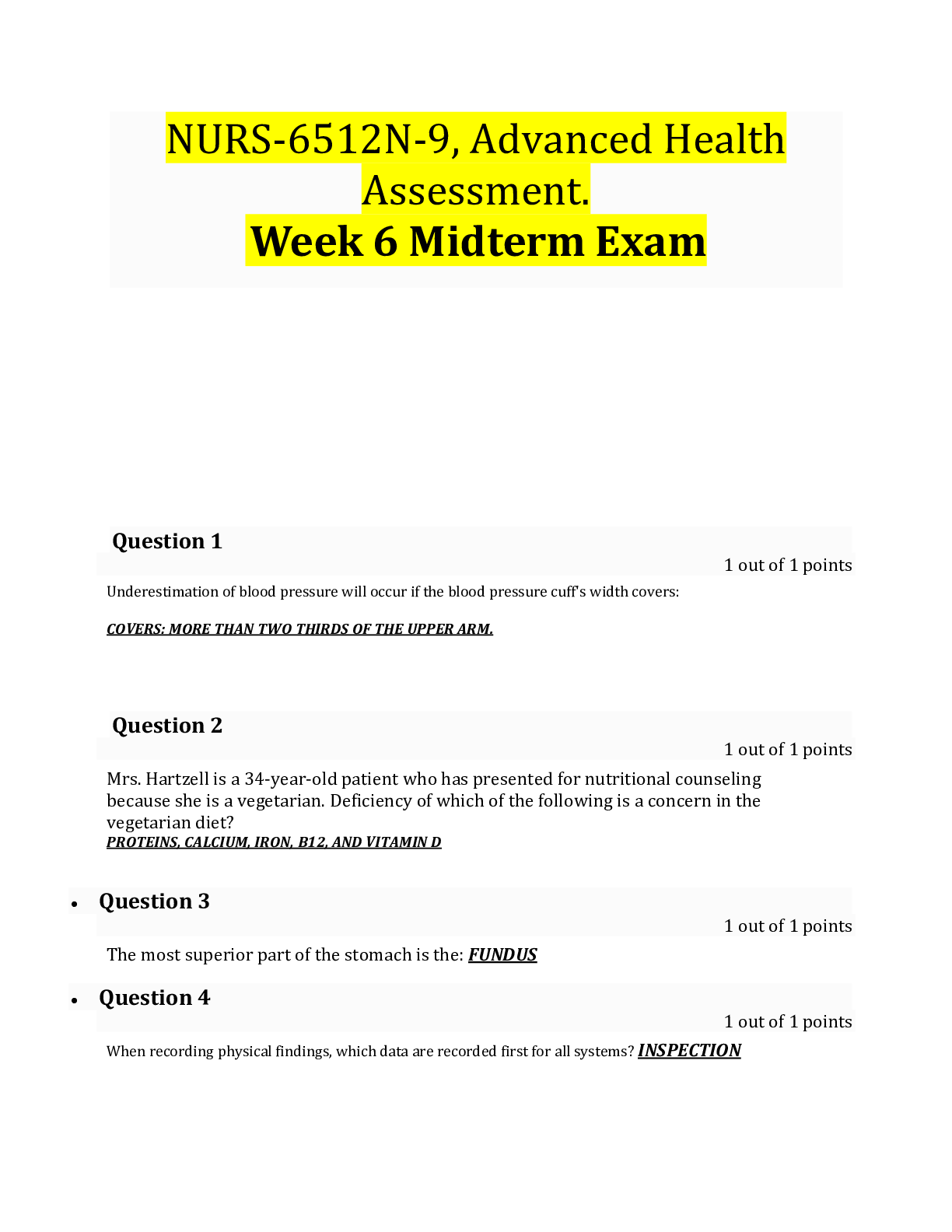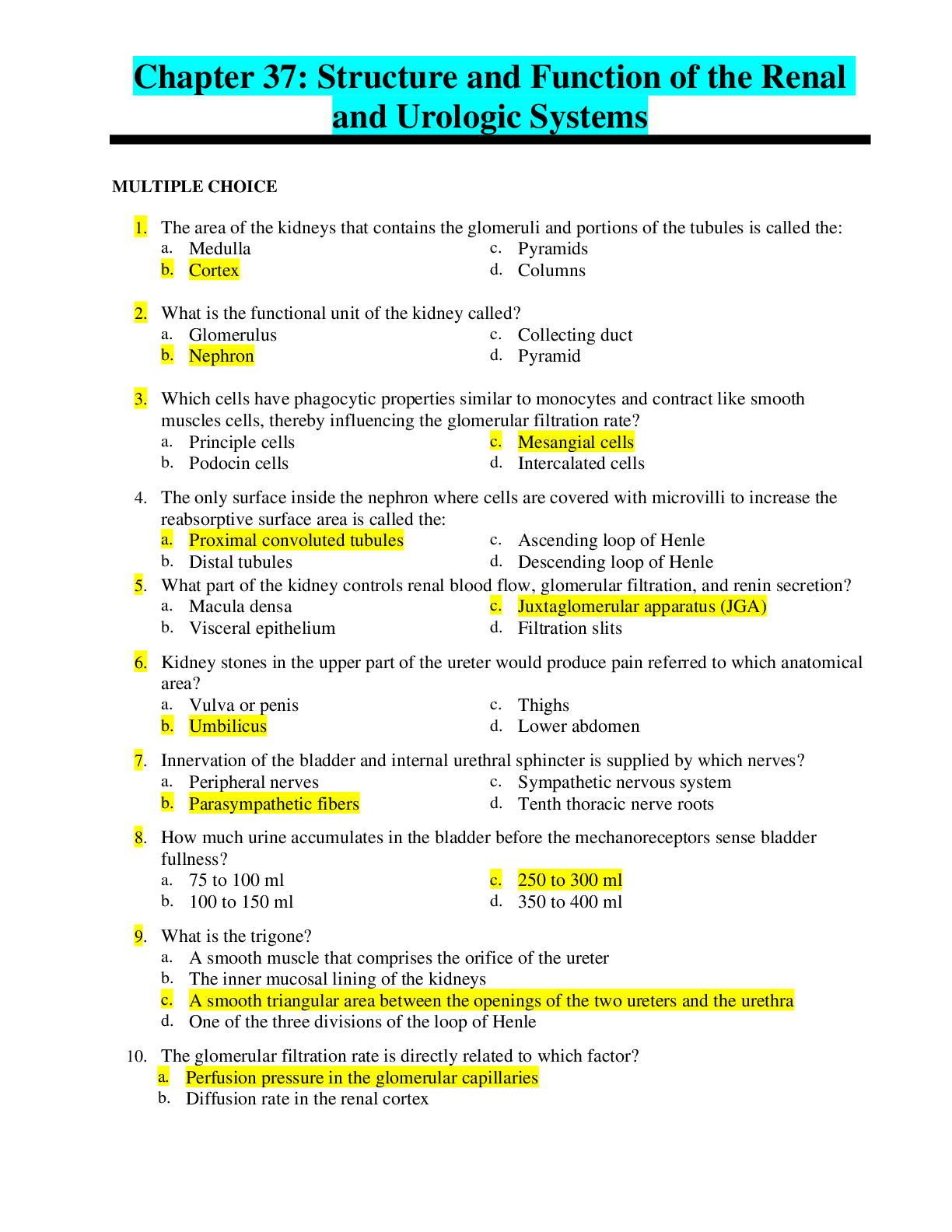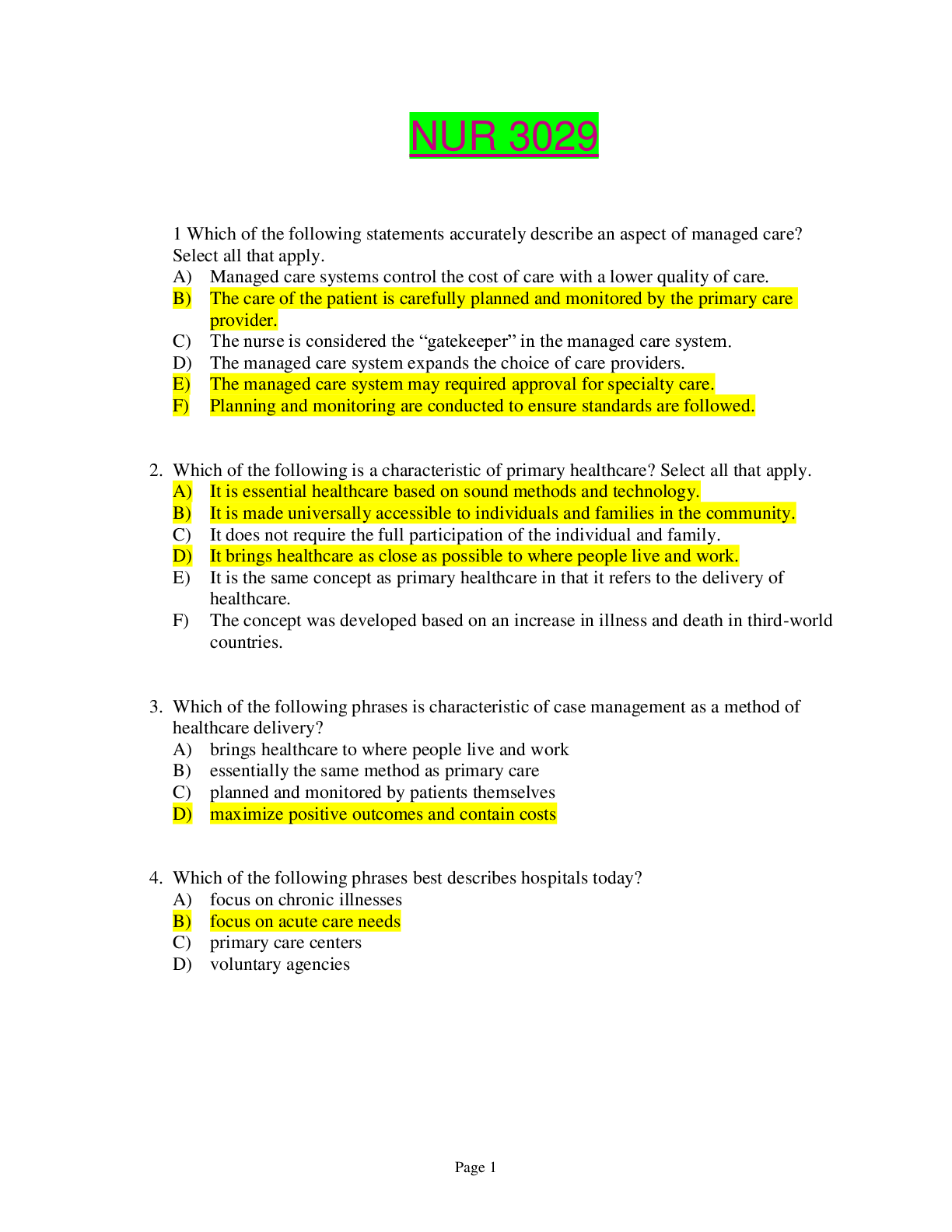*NURSING > QUESTIONS & ANSWERS > Columbus State University > NURSING 1230/NRSG 1230 > NURSING 1230/NRSG 1230 Chapter 3: Care of the P (All)
Columbus State University > NURSING 1230/NRSG 1230 > NURSING 1230/NRSG 1230 Chapter 3: Care of the Patient with an Integumentary Disorder.
Document Content and Description Below
Chapter 3: Care of the Patient with an Integumentary Disorder MULTIPLE CHOICE 1. What should the nurse do when administering a therapeutic bath to a patient who has severe pruritus? a. Use Bur... ow’s solution to help promote healing b. Rub the skin briskly to decrease pruritus c. Limit bathing to 3 times a week d. Ensure that bath area is at least 85 degrees and dehumidified 2. A frail, older adult home health patient who had chickenpox as a child has been exposed to varicella (chickenpox) several days ago. What should the nurse do? a. Assess frequently for herpes zoster b. Be aware of the patient’s immunity to chickenpox c. Encourage the patient to have a pneumonia vaccine d. Arrange for the patient to receive gamma globulin 3. A patient has herpes zoster (shingles) and is being treated with acyclovir (Zovirax). What should the nurse do when administering this drug? a. Apply lightly, being careful not to completely cover the lesion b. After application, wrap in warm wet dressings c. Use gloves d. Rub medication into lesions 4. A child has been sent to the school nurse with pruritus and honey-colored crusts on the lower lip and chin. The nurse believes these lesions most likely are: a. chickenpox. b. impetigo. c. shingles. d. herpes simplex type I. 5. A school nurse assesses a child who has an erythematous circular patch of vesicles on her scalp with alopecia and complains of pain and pruritus. Why would the nurse use a Woods lamp? a. To dry out the lesions b. To reduce the pruritus c. To kill the fungus d. To cause fluorescence of the infected hairs 6. A patient, age 46, reports to his physician’s office with urticaria with elevated lesions that are white in the center with a pale red border on hands and arms. He says, “It itches like crazy.” Which type of lesion would the nurse include in her documentation? a. Macules b. Plaques c. Wheals d. Vesicles 7. The home health nurse assessing skin lesions uses the PQRST mnemonic as a guide. What does the S in this guide indicate? a. Severity of the symptoms b. Site of the lesions c. Symptomatology of the lesions d. Surface area of the lesions 8. What would the nurse stress to the 17-year-old girl who has been prescribed Accutane for her acne? a. Avoid alcoholic beverages b. Drink at least 1000 mL of fluid daily c. Use dependable birth control to avoid pregnancy d. Avoid exposure to the sun 9. A 30-year-old African American had surgery 6 months ago and the incision site is now raised, indurated, and shiny. This is most likely which type of tissue growth? a. Angioma b. Keloid c. Melanoma d. Nevus 10. A patient, age 37, sustained partial- and full-thickness burns to 26% of the body surface area. When would the greatest fluid loss resulting from the burns occur? a. Within 12 hours after burn trauma b. 24 to 36 hours after burn trauma c. 24 to 48 hours after burn trauma d. 48 to 72 hours after burn trauma 11. Most of the deaths from burn trauma in the emergent phase that require a referral to a burn center result from: a. infection. b. arrhythmias with cardiac arrest. c. hypovolemic shock and renal failure. d. adrenal failure. 12. The nurse takes into consideration that carbon monoxide intoxication secondary to smoke inhalation is often fatal because carbon monoxide: a. binds with hemoglobin in place of oxygen. b. interferes with oxygen intake. c. is a respiratory depressant. d. is a toxic agent. 13. A nurse arrives at an accident scene where the victim has just received an electrical burn. What is the nurse’s primary concern? a. The extent and depth of the burn b. The sites of entry and exit c. The likelihood of cardiac arrest d. Control of bleeding 14. A patient, age 27, sustained thermal burns to 18% of her body surface area. After the first 72 hours, the nurse will have to observe for the most common cause of burn-related deaths, which is: a. shock. b. respiratory arrest. c. hemorrhage. d. infection. 15. Two weeks after a severe burn of over 20% of the body, the patient vomits bright red blood. Which condition is most likely? a. Curling ulcer b. Paralytic ileus c. Hypoglycemia perforation of the stomach by the NG tube d. Gastritis 16. When providing the open method of treatment for a patient who is 52 years old with burns to the lower extremities, what would a nurse include in the nursing plan? a. Change the dressing using good medical asepsis b. Provide an analgesic immediately after the dressing change c. Perform circulation checks every 2 to 4 hours d. Keep the room temperature at 85° F (29.4° C) to prevent chilling 17. The nurse has staged a pressure ulcer that has a shallow crater with a dry pink wound bed as a: a. stage I b. stage II c. stage III d. stage IV 18. What would the nurse dressing a necrotic pressure ulcer with a minimal exudate most likely use? a. Hydrocolloid dressing b. Alginate dressing c. Hydrofiber dressing d. Transparent film 19. The nurse is caring for a 26-year-old male patient who was burned 72 hours ago. He has partial-thickness burns to 24% of his body surface area. He begins to excrete large amounts of urine. What should the nurse do? a. Increase the IV rate and monitor for burn shock b. Monitor for signs of seizure activity. c. Assess for signs of fluid overload d. Raise the foot of the bed and apply blankets TOP: Burns KEY: Nursing Process Step: Assessment MSC: NCLEX: Physiological Integrity 20. A patient with severe eczema is starting a coal tar derivative treatment. What should the nurse include in the teaching plan for the patient relative to this treatment? a. Drink at least 1000 mL of fluid daily b. Avoid exposure to sunlight for 72 hours after use c. Bathe with an astringent soap d. Reduce intake of high calcium foods 21. What should the nurse examine in assessing a patient for tinea corporis? a. Soles of the feet b. Scalp c. Armpits d. Abdomen 22. What is the initial intervention for relief of the pruritus of dermatitis venenata? a. Apply baking soda to lesions b. Wash area with copious amounts of water c. Apply cool compresses continuously d. Expose area to air 23. The nurse debriding a burn wound explains that the purpose of debridement is to: a. increase the effectiveness of the skin graft. b. prevent infection and promote healing. c. promote suppuration of the wound. d. promote movement in the affected area. 24. A patient has been admitted to the hospital with burns to the upper chest. The nurse notes singed nasal hairs. The nurse needs to assess this patient frequently for which condition? a. Decreased activity b. Bradycardia c. Respiratory complications d. Hypertension 25. Which may indicate a malignant melanoma in a nevus on a patient’s arm? a. Even coloring of the mole b. Decrease in size of the mole c. Irregular border of the mole d. Symmetry of the mole 26. A nurse can assess cyanosis in a dark-skinned patient by noting the color of the: a. conjunctiva. b. sclera. c. lips and mucous membranes. d. soles of the feet. 27. A patient developed a severe contact dermatitis of the hands, arms, and lower legs after spending an afternoon picking strawberries. The patient states that the itching is severe and cannot keep from scratching. Which instruction would be most helpful in managing the pruritus? a. Use cool, wet dressings and baths to promote vasoconstriction. b. Trim the fingernails short to prevent skin damage from scratching. c. Expose the areas to the sun to promote drying and healing of the lesions. d. Wear cotton gloves and cover all other affected areas with clothing to prevent environmental irritation. 28. What is the best instruction by the nurse regarding reducing the risk factors for melanoma? a. Avoid exposure to the sun and use protective measures when exposure occurs. b. Have all nevi removed. c. Watch for changes in moles, especially on the back. d. Use a sun lamp for tanning. 29. Which patient instruction should the nurse include in the teaching plan relative to the management of systemic lupus erythematosus? a. Maintain a balance between rest and activity b. Increase activity to promote mobility c. Increase exposure to the sun to increase vitamin D absorption d. Increase sodium consumption 30. Which patient statement indicates that more teaching is needed regarding antibiotic therapy for the treatment of cellulitis? a. ”My skin is cleared up. I don’t think I need the medication anymore.” b. “Cellulitis can come back at any time.” c. “If I had washed that scratch with soap and water, I probably would not have gotten cellulitis.” d. ”Cellulitis is contagious.” 31. What should a patient be assessed for upon the diagnosis of genital herpes? a. Hepatitis B b. Syphilis c. Human immunodeficiency virus (HIV). d. Cirrhosis 32. The school nurse recognizes the signs of scabies when a child presents with: a. small fluid filled blisters that sting when scratched. b. dry scaly patches in body creases that itch. c. wavy threadlike lines on the body and pruritus. d. cluster of papular lesions with pruritus. 33. Melanocytes give rise to the pigment melanin, which is responsible for skin color. Where can the melanocytes be found? a. Dermis b. Superficial fascia c. Epidermis d. Loose connective tissue MULTIPLE RESPONSE 34. Which of the following are major functions of the skin? (Select all that apply.) a. Excretion of wastes b. Protection c. Vitamin C synthesis d. Temperature regulation e. Prevention of dehydration 35. During primary survey assessment of a burn patient, the nurse checks for which of the following as early signs of carbon monoxide poisoning? (Select all that apply.) a. Dizziness b. Urticaria c. Vomiting d. Headache e. Vertigo f. Unsteady gait 36. What is a common diagnostic criterion for identifying systemic lupus erythematosus (SLE)? (Select all that apply.) a. Butterfly rash over nose and cheeks b. Photosensitivity c. Severe abdominal pain d. Skin ulcers e. Polyarthralgias and polyarthritis f. Immobility 37. Which of the following are nursing interventions and patient teaching for the treatment of head lice and scabies? (Select all that apply.) a. Clothing, linens, and bath articles thoroughly cleaned in hot water b. Stress nature and transmission of the disease c. Special carbohydrate diet to promote healing d. Complete isolation from the public COMPLETION 38. The most deadly skin cancer is ________________. ANS: 39. The three major glands of the skin are __________, ___________, and __________. 40. The nurse making the initial assessment of a burned patient in the emergency room observes that the entire right arm (anterior and posterior), right anterior leg, chest, and abdomen are covered with reddened skin and blisters. Using the Rule of Nines, the nurse estimates the percentage of burn to be______%. OTHER 41. Prioritize the intervention of the first responder to the victim during the emergent phase of burn management. (Separate letters by a comma and space as follows: A, B, C, D.) a. Transport victim to hospital. b. Cover victim with clean cloth or sheet. c. Stop, drop, and roll. d. Remove all nonadherent clothing and jewelry. e. Provide an open airway. f. Control any bleeding. 42. Prioritize the interventions for a hospitalized severely burned victim during the emergent phase. (Separate letters by a comma and space as follows: A, B, C, D.) a. Tetanus prophylaxis b. Insert Foley catheter c. Insert nasogastric tube d. Establish airway e. Administer analgesics f. Initiate fluid therapy [Show More]
Last updated: 2 years ago
Preview 1 out of 13 pages

Buy this document to get the full access instantly
Instant Download Access after purchase
Buy NowInstant download
We Accept:

Reviews( 0 )
$8.00
Can't find what you want? Try our AI powered Search
Document information
Connected school, study & course
About the document
Uploaded On
Apr 12, 2020
Number of pages
13
Written in
Additional information
This document has been written for:
Uploaded
Apr 12, 2020
Downloads
0
Views
178

